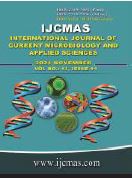


 National Academy of Agricultural Sciences (NAAS)
National Academy of Agricultural Sciences (NAAS)

|
PRINT ISSN : 2319-7692
Online ISSN : 2319-7706 Issues : 12 per year Publisher : Excellent Publishers Email : editorijcmas@gmail.com / submit@ijcmas.com Editor-in-chief: Dr.M.Prakash Index Copernicus ICV 2018: 95.39 NAAS RATING 2020: 5.38 |
Intensive agriculture, while increasing food production, has caused second generation problems in respect of nutrient imbalance including greater mining of soil nutrients to the extent of 10 million tons every year depleting soil fertility, emerging deficiencies of secondary and micronutrients, decline of water table and its quality of water, decreasing organic carbon content, and overall deterioration in soil health. Indian soils not only show deficiency in both primary nutrients (Nitrogen, Phosphorous and Potassium) but also of secondary nutrients (Sulphur, Calcium and Magnesium) and micronutrients (Boron, Zinc, Copper, and Iron etc.) (Ministry of Agriculture, 2015). Improved grain production to meet the food demand of an increasing population has been highly dependent on chemical fertilizer input based on the traditionally assumed notion of ‘high input, high output’, However, crop yield has not increased proportionally with growing fertiliser inputs in recent decades, resulting in low nutrient use efficiency and increased environmental concerns which results in overuse of fertilizers ignores the biological potential of roots or rhizosphere for efficient mobilization and acquisition of soil nutrient. The plant roots and rhizosphere interaction in the Rhizosphere region where plant releases exudates from roots which act as chemical signals. This involves in Nutrient cycling and nutrient transformation. The rhizosphere offers a potential solution to combat these deficiencies and improve soil fertility. Also signalling between plant and rhizosphere is very rich and complex micro biome diversity which they undergoes both interspecies and intraspecies signalling.
Armero J, Requejo R, Jorrin J, Lopez-Valbuena R, Tena M. 2001. Release of phytoalexins and related isoflavonoids from intact chickpea seedlings elicited with reduced glutathione at root level. Plant Physiology and Biochemistry 39, 785–795. https://doi.org/10.1016/S0981-9428(01)01299-2
Badri D V, Quintana N, El Kassis E G, Kim H K, Choi Y H, Sugiyama A, Verpoorte R, Martinoia E, Manter D K, Vivanco J M (2009) An ABC transporter mutation alters root exudation of phytochemicals that provoke an overhaul of natural soil microbiota. Plant Physiol 151:2006–2017. https://doi.org/10.1104/pp.109.147462
Bais, H. P., Park, S. W., Weir, T. L., Callaway, R. M., & Vivanco, J. M. (2004). How plants communicate using the underground information superhighway. Trends in plant science, 9(1), 26-32. https://doi.org/10.1016/j.tplants.2003.11.008
Baudoin, E. et al., (2003) Impact of artificial root exudates on the bacterial community structure in bulk soil and maize rhizosphere. Soil Biol. Biochem. 35, 1183–1192 http://dx.doi.org/10.1016/S0038-0717(03)00179-2
Bertin C, Yang X, Weston LA (2003) The role of root exudates and allelochemicals in the rhizosphere. Plant Soil 256:67–83. http://dx.doi.org/10.1023/A:1026290508166
Bolan N S (1991) A critical review on the role of mycorrhizal fungi in the uptake of phosphorus by plants. Plant Soil 134:189–207 https://doi.org/10.1007/BF00012037
Brundrett M C (2009) Mycorrhizal associations and other means ofnutrition of vascular plants: understanding the global diversity of host plants by resolving conflicting information and developing reliable means of diagnosis. Plant Soil 320:37– 77. https://doi.org/10.1007/s11104-008-98779
Butler, J. L. et al., (2003) Microbial community dynamics associated with rhizosphere carbon flow. Appl. Environ.Microbiol. 69, 6793–6800 https://doi.org/10.1128/aem.69.11.6793-6800.2003
Canarini A, Kaiser C, Merchant A, Richter A, Wanek W (2019) Root exudation of primary metabolites: mechanisms and their roles in plant responses to environmental stimuli. Front Plant Sci. https://doi.org/10.3389/fpls.2019.00157
Cesco S, Neumann G, TomasiN, Pinton R, Weisskopf L. 2010. Release of plant-borne flavonoids into the rhizosphere and their role in plant nutrition. Plant and Soil 329, 1– 25. http://dx.doi.org/10.1007/s11104-009-0266-9
Cesco, S., Mimmo, T., Tonon, G., Tomasi, N., Pinton, R., Terzano, R., et al., (2012). Plant- borne flavonoids released into the rhizosphere: impact on soil bio-activities related to plant nutrition: A review. Biol. Fertil. Soils 48, 123–149. https://doi.org/10.1007/s00374-011- 0653-2
Chagas, F.O.; Pessotti, R.D.C.; Caraballo-Rodríguez, A.M.; Pupo, M.T. Chemical Signaling Involved in Plant-Microbe Interactions. Chem. Soc. Rev. 2018, 47, 1652–1704. https://doi.org/10.1039/C7CS00343A
Cocking, E.C. (2003) Endophytic colonisation of plant roots by nitrogen-fixing bacteria. Plant Soil 252, 169–175 https://doi.org/10.1023/A:1024106605806
Coskun D, Britto D T, Shi W, Kronzucker H J (2017) How plant root exudates shape the nitrogen cycle. Trends Plant Sci 22:661–673 https://doi.org/10.1016/j.tplants.2017.05.004
Ferrer, J. L., Austin, M. B., Stewart, C., Jr., Noel, J. P. (2008). Structure and function of enzymes involved in the biosynthesis of phenylpropanoids. Plant Physiol. Biochem. 46 (3),356–370. https://doi.org/10.1016/j.plaphy.2007.12.009
Gao M, Yang M, Ma X, Xie D, Wu C, Wang Q (2021) Effect of codigestion of tylosin fermentation dreg and food waste on anaerobic digestion performance. Bioresour Technol 325:124693. https://doi.org/10.1016/j.biortech.2021.124693
Han, L.; Zhang, H.; Bai, X.; Jiang, B. The Peanut Root Exudate Increases the Transport and Metabolism of Nutrients and Enhances the Plant Growth-Promoting Effects of BurkholderiaPyrrocinia Strain P10. BMC Microbiol. 2023, 23, 85. https://doi.org/10.1186/s12866-023-02818-9
Hirsch, A.M. et al., (2003) Molecular signal and receptors: controlling rhizosphere interactions between plants and other organisms. Ecology 84, 858–868.
Högberg P (1990) 15N natural abundance as a possible marker of the ectomycorrhizalhabit of trees in mixed African woodlands. New Phytol 115:483–486 https://doi.org/10.1111/j.1469-8137.1990.tb00474.x
Hu L, Robert CAM, Cadot S, Zhang X, Ye M, Li B, Manzo D, ChervetN, Steinger T, van der Heijden MGA, Schlaeppi K, Erb M (2018) Root exudate metabolites drive plant-soil feedbacks on growth and defense by shaping the rhizospheremicrobiota. Nat Commun 9: 2738. https://doi.org/10.1038/s41467-018-05122-7
Huang AC, Jiang T, Liu Y-X, Bai YC, Reed J, Qu B, Goossens A, Nützmann HW, Bai Y, Osbourn A (2019) A specialized metabolic network selectively modulates Arabidopsis rootmicrobiota. Science 364:eaau6389. https://doi.org/10.1126/science.aau6389
Iannucci, A.; Fragasso, M.; Platani, C.; Papa, R. Plant Growth and Phenolic Compounds in the Rhizosphere Soil of Wild Oat (Avena fatua L.). Front. Plant Sci. 2013, 4, 509. https://doi.org/10.3389/fpls.2013.00509
Korenblum, E.; Dong, Y.; Szymanski, J.; Panda, S.; Jozwiak, A.; Massalha, H.; Meir, S.; Rogachev, I.; Aharoni, A. (2020) Rhizosphere Microbiome Mediates Systemic Root Metabolite Exudation by Root-to-Root Signaling. Proc. Natl. Acad. Sci. USA 2020, 117, 3874–3883. https://doi.org/10.1073/pnas.1912130117
Lambers H, Chapin FS III, Pons TL (2008b) Plant physiological ecology, 2nd edn. Springer, New York
Lattanzio, V.; Lattanzio, V.M.; Cardinali, A. Role of Phenolics in the Resistance Mechanisms of Plants against Fungal Pathogens and Insects; Research Signpost: Kerala, India, 2006; Volume 661, ISBN 8130800349.
Liu, Y.; Xu, Z.; Chen, L.; Xun, W.; Shu, X.; Chen, Y.; Sun, X.; Wang, Z.; Ren, Y.; Shen, Q.; et al., Root Colonization by Beneficial Rhizobacteria. FEMS Microbiol. Rev. 2024, 48, fuad066. https://doi.org/10.1093/femsre/fuad066
Meena, V. S., Meena, S. K., Verma, J. P., Kumar, A., Aeron, A., Mishra, P. K.,... &Dotaniya, M. L. (2017). Plant beneficial rhizospheric microorganism (PBRM) strategies to improve nutrients use efficiency: a review. Ecological Engineering, 107, 8-32. http://dx.doi.org/10.1016/j.ecoleng.2017.06.058
Ministry of Agriculture, 2015
Mendes, R.; Kruijt, M.; de Bruijn, I.; Dekkers, E.; van der Voort, M.; Schneider, J.H.M.; Piceno, Y.M.; DeSantis, T.Z.; Andersen, G.L.; Bakker, P.A.H.M.; et al., Deciphering the RhizosphereMicrobiome for Disease-Suppressive Bacteria. Science 2011, 332, 1097–1100. https://doi.org/10.1126/science.1203980
Moe, L.A. Amino Acids in the Rhizosphere: From Plants to Microbes. Am. J. Bot. 2013, 100, 1692–1705. https://doi.org/10.3732/ajb.1300033
Parmar, Krupa&Dafale, Nishant& Pal, Rajesh &Tikariha, Hitesh &Purohit, Hemant. (2018). An Insight into Phage Diversity at Environmental Habitats using Comparative Metagenomics Approach. Current Microbiology. 75. 1-10. https://doi.org/10.1007/s00284-017-1357- 0.
Peng, M.; Jiang, Z.; Zhou, F.; Wang, Z. From Salty to Thriving: Plant Growth Promoting Bacteria as Nature’s Allies in Overcoming Salinity Stress in Plants. Front. Microbiol. 2023, 14, 1169809. https://doi.org/10.3389/fmicb.2023.1169809
Pischetsrieder M (2018) Global food-related challenges: what chemistry has achieved and what remains to be done. AngewChemInt Ed 57: 11476–11477. https://doi.org/10.1002/anie.201803504
Richardson, A.E., Barea, JM., McNeill, A.M. et al. Acquisition of phosphorus and nitrogen in the rhizosphere and plant growth promotion by microorganisms. Plant Soil 321, 305–339 (2009). https://doi.org/10.1007/s11104-009-9895-2
Raval, Vaishali & Sahay, Nirmal. (2021). Isolation of Microbes from Valley of Flower (VOF) India and Screening of Actinomycetes for their Antibiotic Potential. 2021. https://doi.org/10.37628/IJIBB.
Roy, A., Khan, A., Ahmad, I., Alghamdi, S., Rajab, B. S., Babalghith, A. O., et al., (2022). Flavonoids a bioactive compound from medicinal plants and its therapeutic applications. BioMed. Res. Int. 2022, 5445291. https://doi.org/10.1155/2022/5445291
Ruan J, Zhou Y, Zhou M, Yan J, KhurshidM,WengW, Cheng J, Zhang K (2019) Jasmonic Acid Signaling Pathway in Plants. Int J MolSci20. https://doi.org/10.3390/ijms20102479
Samanta, A., Das, G., Das, S. K. (2011). Roles of flavonoids in plants. Int. J. Pharm. Sci. Technol. 6 (1), 12–35.
Sarah LL, Paredes SH, Lundberg DS et al., (2015) Salicylic acid modulates colonization of the root microbiome by specific bacterial taxa. Science 349:860–864. https://doi.org/10.1126/science.aaa8764
Sasse, J.; Martinoia, E.; Northen, T. Feed Your Friends: Do Plant Exudates Shape the Root Microbiome? Trends Plant Sci. 2018, 23, 25–41. https://doi.org/10.1016/j.tplants.2017.09.003
Schmidt PE, Broughton WJ, Werner D. 1994. Nod-factors of Bradyrhizobium japonicum and Rhizobium sp. NGR234 induce flavonoid accumulation in soybean root exudate. Molecular PlantMicrobe Interactions 7, 384–390. https://doi.org/10.1094/MPMI-7-0384
Sharifi, R.; Jeon, J.S.; Ryu, C.M. Belowground Plant-Microbe Communications via Volatile Compounds. J. Exp. Bot. 2022, 73, 463–486. https://doi.org/10.1093/jxb/erab465
Singh BK, Trivedi P, Egidi E, Macdonald CA, Delgado-Baquerizo M (2020) Crop microbiome and sustainable agriculture. Nat RevMicrobiol 18:601–602. https://doi.org/10.1038/s41579-020-00446-y
Stringlis IA, Yu K, Feussner K, de Jonge R, van Bentum S, van Verk MC, Berendsen RL, Bakker PAHM, Feussner I, Pieterse CMJ (2018) MYB72-dependent coumarin exudation shapes root microbiome assembly to promote plant health. ProcNatlAcad Sci U S A 115: E5213–E5222. https://doi.org/10.1073/pnas.1722335115
Sugiyama, A., Yazaki, K. (2014). Flavonoids in plant rhizospheres: secretion, fate and their effects on biological communication. Plant Biotechnol. 31 (5), 431–443. https://doi.org/10.5511/plantbiotechnology.14.0917a
Tian, T.; Sun, B.; Shi, H.; Gao, T.; He, Y.; Li, Y.; Liu, Y.; Li, X. Sucrose Triggers a Novel Signaling Cascade Promoting Bacillus subtilisRhizosphere Colonization. ISME J. 2021, 15, 2723–2737. https://doi.org/10.1038/s41396-021-00966-2
Tolove, S.N. et al., (2003) Progress in selected areas of rhizosphere on Pacquisition. Aust. J. Soil Res. 41, 471–499 http://dx.doi.org/10.1071/SR02130
Vílchez, J.I.; Yang, Y.; He, D.; Zi, H.; Peng, L.; Lv, S.; Kaushal, R.; Wang, W.; Huang, W.; Liu, R.; et al., DNA Demethylases Are Required for Myo-Inositol-Mediated Mutualism between Plants and Beneficial Rhizobacteria. Nat. Plants 2020, 6, 983–995. https://doi.org/10.1038/s41477-020-0707-2
Wang, L., Chen, M., Lam, P. Y., Dini-Andreote, F., Wei, Z. (2022). Multifaceted roles of flavonoids mediating plant-microbe interactions. Microbiome 10, 233. https://doi.org/10.1186/s40168-022-01420-x
Wang, P.; Ma, L.; Ge, J.; Feng, F.; Wan, Q.; Zeng, D.; Yu, X. Colonization Mechanism of EndophyticEnterobacter Cloacae TMX-6 on Rice Seedlings Mediated by Organic Acids Exudated from Roots. J. Agric. Food Chem. 2023, 71, 4802–4809. https://doi.org/10.1021/acs.jafc.2c08647
Yuan J, Zhao J, Wen T, Zhao M, Li R, Goossens P, Huang Q, Bai Y, Vivanco JM, Kowalchuk GA, Berendsen R L, Shen Q (2018) Root exudates drive the soil-borne legacy of above ground pathogen infection. Microbiome 6:156. https://doi.org/10.1186/s40168-018-0537-x
Zhalnina, K.; Louie, K.B.; Hao, Z.; Mansoori, N.; Da Rocha, U.N.; Shi, S.; Cho, H.; Karaoz, U.; Loqué, D.; Bowen, B.P.; et al., Dynamic Root Exudate Chemistry and Microbial Substrate Preferences Drive Patterns in Rhizosphere Microbial Community Assembly. Nat. Microbiol. 2018, 3, 470–480. https://doi.org/10.1038/s41564-018-0129-3
 |
 |
 |
 |
 |